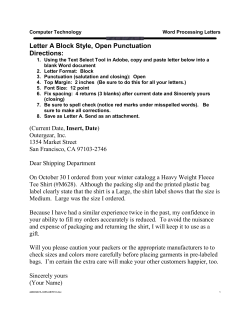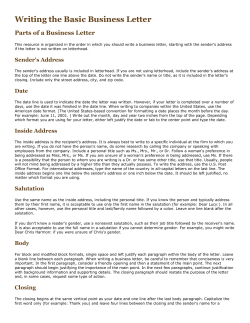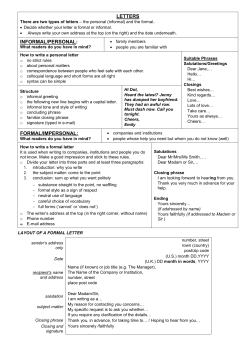
Share purchase agreements Purchase price mechanisms and current trends in practice
Share purchase agreements Purchase price mechanisms and current trends in practice Share Purchase Agreements Ernst & Young October 2008 Undertaking a professional due diligence exercise has become an established part of the transaction process. The due diligence findings are typically taken into account either in the purchase price, including the price mechanism, or in the contractual terms. This brochure provides an overview of the link between due diligence and price mechanisms, the main types of price mechanisms and trends in these mechanisms. Table of contents Overview 4 Price adjustment mechanisms based on Closing Accounts 4 Locked box mechanism 4 Price adjustment mechanisms 5 Net debt mechanism 5 Net working capital mechanism 6 Capex mechanism 6 Price adjustment mechanisms - combinations 6 Locked box mechanism 7 Locked box: old book new cover? 7 Analysis 8 Changing trends in price mechanisms 8 Price adjustments – trends 9 Price adjustments – possible definitions 9 Conclusion 10 Price adjustment mechanisms 10 Locked box mechanism 10 Share Purchase Agreements Ernst & Young October 2008 Overview There are two common ways of determining the purchase price of a company acquired in a share deal: the parties involved can stipulate in the share purchase agreement (“SPA”) either a fixed purchase price based on the position of the company at a particular reference date (for example the date of the last audited accounts) - a “locked box” mechanism or they can agree a basic price subject to adjustment, where the adjustment is usually based on the condition of the company at closing (“price adjustment mechanism based on Closing Accounts). Once a SPA is signed, it may take several weeks or even months until closing occurs and legal title of the target company is transferred to the buyer. Between signing and clos- ing, the buyer is exposed to both the risk of value erosion at the target company (due to losses, for example) and the risk of value leaking out of the company (by paying out dividends or bonuses, for example). In practice, the buyer is also exposed to the risk of value erosion and leakage between the date on which the valuation is based and the date of signing unless the buyer is able to continually update the valuation and price information until the date of signing. Within both a fixed-price deal mechanism and a price adjustment mechanism there are various methods a buyer can employ to protect against value erosion and value leakage. Price adjustment mechanisms based on Closing Accounts ► ► ► ► ► ► Financial due diligence based on the last statutory financial statements as of 31 Dec. 20XX. The final purchase price consists of a headline price plus/ minus purchase price adjustments. Purchase price adjustments are typically defined in relation to specific target values at the closing date which generate one-for-one price adjustments. Risks and opportunities do not fully pass to the buyer until the closing date. The seller maintains the risks and rewards associated with issues covered by price adjustments up to the closing date. The buyer assumes risks for items not covered by price adjustments on signing and will usually seek protection in these areas through “covenants of conduct” or “material adverse change” clauses in the SPA. 31 Dec. 20XX 28 Feb. 20X1 Balance sheet reference date Due diligence Letter of intent 31 May 20X1 t Negotiation Signing Reference date Closing Covenants of conduct Guarantees Price adjustments Locked box mechanism ► ► ► ► ► ► Financial due diligence based on the last statutory financial statements as of 31 Dec. 20XX. Stipulation of a fixed purchase price based on the most recent set of audited financial statements (31 Dec. 20XX) or on equivalent interim financial statements (locked box date). Risks pass to the buyer as of the locked box date (unless protected by “material adverse change” clauses). The buyer will receive the benefits of the target company cash flows from the locked box date. Clauses in the SPA provide protection against potential value erosion and leakage between the locked box date and the closing date (anti-leakage and pre-completion covenants). Payment takes place on the closing date. The seller is typically “compensated” for the time lag between the locked box date and payment date by charging a form of interest on the purchase price for this period. Share Purchase Agreements Anti-leakage covenant Locked box date Pre-completion covenants Buyers risk and opportunities Sellers risk and opportunities Figure 1 – Transaction overview – price adjustments based on Closing Accounts and locked box mechanism Ernst & Young October 2008 3 Price adjustment mechanisms Purchase price adjustments aim to protect the buyer against value erosion and value leakage at the target company until the closing date. At the same time, they should reward the seller for managing the business well until closing. Price adjustments are usually calculated on the basis of a target value. Target values are typically based on selected balance sheet items at the date of the last set of audited accounts (the Reference Date). These values are then calculated on the same basis at closing based on financial accounts at that date (“Closing Accounts”). The price adjustment is calculated as the difference between the target value and the actual amount at closing. The choice of mechanism needs to be carefully considered to avoid the risk of double-counting and reduce the possibility of manipulation. Net debt and net working capital adjustment mechanisms are two of the most frequently used. They are usually used in conjunction with one another. Assets Cash and cash equivalents Financial liabilities Non-current provisions Inventories Trade receivables Prepayments Trade payables Deferred revenues Deferred taxes Other assets Deferred taxes Other provisions/liabilities Intangible assets Property, plant & equipment Financial assets Equity A number of price adjustment mechanisms are used in practice. Figure 2 indicates how different mechanisms can be used to cover different parts of the balance sheet. In addition to adjustments based on the balance sheet, further alternative price adjustment mechanisms can be used. These may include key performance indicators (such as assets under management), which are neither reported in the income statement nor the balance sheet, or an earn-out mechanism. An earn-out calculates the price to be paid based on future earnings and/or balance sheet metrics. Liabilities Net debt mechanism Net working capital mechanism Separate analysis Capex Figure 2 – Possible price adjustments Net debt mechanism ► Agreeing upon a net debt mechanism usually requires the net (financial) debt at closing to be deducted from the purchase price. The implicit net debt target is then zero. This procedure is often referred to as the “cash and debt free” mechanism. Financial due diligence work required: ► Identify all debt and cash positions. ► Identify “debt-like items”, such as pension liabilities or finance lease liabilities that could be included in the definition of net debt. ► There is no standard definition for net debt (difference between cash and debt). Debt typically includes all interest-bearing financial liabilities. However, debt can also include debt-like items such as pension provisions, lease liabilities and customer advances. Determining which positions should be included in the definition of net debt is part of the SPA negotiation process. ► A net debt agreement does not protect a buyer from changes in other balance sheet positions. Therefore, further adjustment mechanisms, such as the net working capital mechanism, should be used as well. 4 Share Purchase Agreements Ernst & Young October 2008 Net working capital mechanism The net working capital mechanism is based on a target amount which should reflect the level required to operate the business. The target is often based on the amount at the Reference Date or on an average measurement, for example the average over the last 12 months. ► Variations from the target at the closing date lead to an increase/decrease in the purchase price. ► As with the net debt mechanism, there is no standard definition of net working capital. For this reason, the process of determining which positions are included in the definition of net working capital forms part of the SPA negotiation process. ► The definition of net working capital should be used in conjunction with the net debt definition in order to avoid the double-counting of any balance sheet items. Financial due diligence work required: ► Identify relevant balance sheet positions that should be included in the net working capital definition. ► Understand the accounting policies and estimates used to calculate working capital items in the balance sheet. ► Conduct a comprehensive analysis of the working capital over time to determine the impacts of seasonality and the normal level of net working capital required to operate the business. ► Assist in quantifying the appropriate net working capital target, taking into consideration seasonality, changes in the underlying business and the anticipated closing date. ► Identify non-operating and/or one-off items impacting historical working capital in order to determine the appropriateness of including them in the definition of net working capital or net debt and the associated targets included in the SPA. Capex mechanism Price adjustments can also be used to control investment spending between signing and closing. Capex mechanisms typically restrict or require investment spending in line with agreed or budgeted amounts. The purchase price is then adjusted for the difference between the budgeted and executed investments. The capex mechanism therefore protects the buyer from the risk that the seller will optimize the level of net debt at closing by deferring investment spending. Financial due diligence work required: ► Analyze historical and budgeted capital investments. ► Identify deferred investments which may require capital funding by the buyer post-closing. Price adjustment mechanisms – combinations By combining the three adjustment mechanisms (net debt, net working capital and capex) most balance sheet positions, with the exception of equity accounts, can be protected up until closing. Where purchase price adjustment mechanisms do not cover all balance sheet positions at the closing date, the following risks should be considered: ► Certain balance sheet positions may be reclassified and therefore omitted from the price adjustment calculation; and/or Share Purchase Agreements ► Price adjustment mechanisms may be manipulated in order to change the price. For example applying the net working capital mechanism without a net debt mechanism allows the seller to manipulate the closing accounts and hence the price. For example, paying all creditors would lead to an increase in the net working capital but its negative effect on the net debt (i.e. less cash and cash equivalents) would remain unconsidered. Ernst & Young October 2008 5 Locked box mechanism As a fixed price mechanism, the locked box excludes the possibility of price adjustments at the closing date. One immediate advantage is the avoidance of disputes over price adjustments and the closing accounts upon which the adjustments are typically based. Because there is no opportunity to adjust the purchase price after closing (except through indemnities or other breaches of contract), typical concerns regarding the quality of the acquired net assets and the risk that the target suffers value erosion between signing and closing must be considered by the buyer when calculating the purchase price. Difficulties in monitoring for potential value erosion up to closing can occur if: ► The target company is unable to present reliable monthly financial statements, and/or ► The company is undergoing restructuring. The risk of value erosion between signing and closing is higher if the target’s management is not properly incentivized to continue producing results until closing. A locked box mechanism may include price adjustments such as net working capital or net debt; however, these adjustments are determined on or before the signing date and become part of the fixed price. This allows net working capital and net debt (usually the amounts at the locked box date) and their price impact to be part of the negotiation process but the SPA does not need to include adjustments. Financial due diligence work required: ► Detailed due diligence analysis based on the locked box date, as subsequent purchase price adjustments are not usually possible. ► Current trading analysis from the locked box date until closing. ► Identify potential risks of value leakage such as dividend payments, repayment of company loans or additional management compensation to be covered by antileakage covenants. Locked box: old book new cover? The application of the locked box is a result of the age-long attempt by both buyers and sellers to find a price mechanism which is simple but nevertheless protects against unwelcome surprises. Agreement of a fixed price is clearly the simplest price structure. Historically it was indeed the most common method. Only recently, with the uptake of more sophisticated and complex due diligence and transaction processes, have buyers found it increasingly important to ensure that value cannot leak out of the target between signing and closing. However, as price adjustment clauses began to cause disputes between buyers and sellers, lawyers and financial advisors once again began to favor fixed prices. Since a return to the historical price method was not fully acceptable, improvements to the mechanism were first needed. And so the locked box was born. The difference between the locked box and the traditional method lies primarily in the fact that lawyers and financial experts have developed intelligent anti-leakage clauses, which, as far as possible, protect the buyer from value leaks at the target. For a number of years, transaction specialists saw the price adjustment mechanism based on target values related to the balance sheet as a solution. 6 Share Purchase Agreements Ernst & Young October 2008 Analysis Ernst & Young analyzed the purchase price mechanisms from a sample of 100 SPAs with a view to: ► Identifying trends in purchase price mechanisms. ► Identifying balance sheet positions commonly included within the definition of net debt and net working capital when price adjustments on these measures are applied. Number of SPAs analyzed 100 Examination period 1987 to 2008 Transaction volume Enterprise value Changing trends in price mechanisms Developments in the purchase price adjustment mechanisms between 1987 and 2008 include the following: The choice of either fixed price or price adjustment does not appear to be correlated to transaction volume. ► Until 2001 the large majority of SPAs we sampled applied a fixed price mechanism. ► As shown by the chart below, there is no distinct correlation between the size of a transaction and the type of price mechanism. ► In the period between 2002 and 2005, there was a distinct trend towards purchase price adjustment mechanisms. ► Since 2006 we observed a return towards the use of fixed price mechanisms. However this was accompanied by a tendency to use a more sophisticated, fixed price mechanism - frequently the ‘locked box’. 100% 17 SPAs ► The choice of the mechanism is typically defined according to the specific transaction and dependant on the bargaining power of both parties. 56 SPAs 27 SPAs 100% 80% 36 SPAs 28 SPAs 23 SPAs 13 SPAs < 25 MCHF between 25 and 100 MCHF between 100 and 1000 MCHF < 1000 MCHF 80% 60% 60% 40% 40% 20% 20% 0% 0% 1987-2001 Fixed price agreement 2002-2005 2006-2008 Price adjustments based on Closing Accounts Figure 3 – Purchase price mechanisms trend between 1987-2008 Fixed price agreement Price adjustments based on Closing Accounts Figure 4 - Transaction volume (enterprise value) and purchase price mechanisms Share Purchase Agreements Ernst & Young October 2008 7 Price adjustment mechanisms – trends ► We observed a significant diversification of price adjustments used between 2002 and 2005. ► Only 61% of the sampled SPAs which used a net working capital adjustment also included a net debt adjustment. ► From 2006 we observed a reversal of this trend with net working capital and net debt adjustments becoming the most popular forms of adjustment mechanism. ► Where SPAs had a net working capital adjustment but no net debt adjustment, debt-like items tended to be included in the working capital definition or covered by some other form of adjustment mechanism. ► Earn-out and equity clauses have become less common over the last two years. 100% SPAs with a NWC but no ND mechanism: 80% 60% 39% 40% 20% SPAs with a NWC and an additional ND mechanism: 61% 0% 1997-2001 2002-2005 2006-2008 Net assets Net debt (third) Net debt (I/C) NWC Earn out Equity Capex Other Figure 6 - Link between net working capital and net debt Figure 5 - Purchase price adjustments between 1997-2008 Price adjustment mechanisms – possible definitions Net debt Net working capital ► 100% of the SPAs with a net debt adjustment included cash and short and long-term liabilities in their definition of net debt. However, a large number of other debt-like items were also included in debt definitions. ► 100% of the SPAs with a net working capital adjustment included accounts receivable, inventories, and accounts payable in their definition of net working capital. However, a large number of other balance sheet items have also been included in the net working capital definition. ► No standard net debt definition was observed in our SPA sample. This is consistent with our experience that the debt and debt-like positions to be included within the adjustment definition need to be identified during financial due diligence and negotiated as part of the SPA. Cash & cash equivalents Current financial liabilities Non-current financial liabilities Other non-current liabilities Tax liabilities ► No standard net working capital definition could be identified in our SPA sample. This is also consistent with our experience that the net working capital positions to be included within the adjustment definition need to be identified during financial due diligence and negotiated as part of the SPA. Trade receivables Trade liabilities Other current liabilities Inventories Financial lease liabilities Deferred revenue Prepayments Pension provisions Provisions Other current liabilities Current tax liabilities Deferred revenues Current financial liabilities Provisions Trade liabilities 100% 50% Cash and cash equivalents 50% Debt Pensions provisions 100% Figure 7 – Possible net debt definitions 8 100% 50% Current assets 50% Current liabilities Figure 8 - Possible net working capital definitions Share Purchase Agreements Ernst & Young October 2008 100% Conclusions When entering into a transaction to buy or sell a business consideration should be given to which type of price mechanism is most desirable. The choice may be limited by the negotiation pressure that can be exerted. The agreed mechanism will influence, among other things, the likelihood of post-closing disputes, the level of resources required to manage the closing process, the timing of risks assumed and exposure to the risk of value erosion and value leakage. Some of the main advantages and disadvantages of the locked box and price adjustment mechanisms are outlined below. Price adjustment mechanisms ► Purchase price adjustments are complex in nature and are subject to contentious negotiation and dispute. Comprehensive and comprehendible purchase price adjustments are recommended to reduce unnecessary complexity of definitions and subsequent calculations as well as to reduce the risk of manipulation. ► The classification of the positions to be included in the target value(s) is typically based on balance sheet accounts. These in turn depend on the underlying accounting standards and estimates. The SPA therefore requires a clear definition of the accounting rules. Terms such as “in line with general accounting standards” are insufficiently precise. Our experience indicates this is a contractual area requiring significant and precise accounting and legal input. Unfortunately, it is often neglected during negotiation leading to costly and protracted postclosing disputes. ► Balance sheet positions should be defined precisely and explicitly. Moreover, the adjustment target definitions should cover a significant portion of the balance sheet. For example, a narrow net working capital definition should be complemented by a broad net debt definition and vice versa. This reduces the ability of the seller to manipulate the purchase price by reclassifying certain balance sheet items. ► The Closing Accounts preparation process, timing and dispute resolution procedures need careful formulation. Whether the buyer or seller prepares the Closing Accounts should also be included in the negotiation process. ► The more debt and debt-like positions that are included within the net debt definition, the greater the price adjustment. Therefore, it is in the buyer’s interest to have a broad definition of net debt. ► Our experience indicates that price adjustment mechanisms are currently favored by buyers as they can reduce their risk exposure up to the closing date. Locked box mechanism ► The determination of the fixed price may include a net working capital and/or a net debt purchase price adjustment. In this case, the purchase price adjustment is calculated prior to SPA signing and included in the fixed price. ► Appropriate conduct of business clauses which apply from the locked box date must be included in the SPA (in contrast to a price adjustment mechanism, where these terms typically apply from the signing date). ► The conduct of business clauses should include extensive anti-leakage covenants to prevent value leakage before the closing date. Anti-leakage covenants prohibit items such as dividend payments, repayment of company loans or additional management compensation or employee bonuses paid without the prior consent of the buyer. Share Purchase Agreements ► A locked box avoids both the need to prepare Closing Accounts and the risk of closing account disputes. ► Using a locked box means that price-relevant issues need to be identified during due diligence and taken into account in price negotiations. There is little opportunity to postpone issues until closing as is the case with a price adjustment mechanism. ► Our experience indicates that locked box mechanisms are currently favored by sellers as they allow the seller to (i) gain a higher degree of comfort on the final price (this is particularly useful for the seller in an auction situation) and (ii) avoid potentially time-consuming closing account processes after they have already relinquished control and ownership and typically prefer to concentrate on other business issues. Ernst & Young October 2008 9 Ernst & Young Assurance | Tax | Legal | Transactions | Advisory Ernst & Young’s Transaction Advisory Services provide integrated and objective advisory services. We work with you to evaluate opportunities, to make your transactions more efficient and achieve your strategic goals. Our transaction professionals combine the essential and relevant industry knowledge with transaction management experience to best support you throughout the transaction lifecycle, both globally and locally. It’ s how Ernst & Young makes a difference. Ernst & Young refers to the global organization of member firms of Ernst & Yong Global Limited, each of which is a separate legal entity. Ernst & Young Global Limited, UK, does not provide services to clients. www.ey.com © 2008 Ernst & Young AG All Rights reserved This publication contains information in summary form and is therefore intended for general guidance only. It is not intended to be a substitute for detailed research or the exercise of professional judgment. Neither EYGM Limited nor any other member of the global Ernst & Young organization can accept responsibility for loss occasioned to any person acting or refraining from action as a result of material in this publication. Regarding any specific matter, reference should be made to the appropriate advisor. Chris Tattersall Partner Transaction Support Bleicherweg 21. CH-8022 Zurich Tel: +41 58 286 30 68 Mobile: +41 58 289 30 68 chris.tattersall@ch.ey.com Jvo Grundler Partner Transaction Legal Bleicherweg 21. CH-8022 Zurich Tel: +41 58 286 44 02 Mobile: +41 58 289 44 02 jvo.grundler@ch.ey.com Luise Kremer Assistant Transaction Support Bleicherweg 21. CH-8022 Zurich Tel: +41 58 286 46 84 Mobile: +41 58 289 46 84 Fax: +41 58 286 30 25 luise.kremer@ch.ey.com Share Purchase Agreements Ernst & Young October 2008
© Copyright 2025











